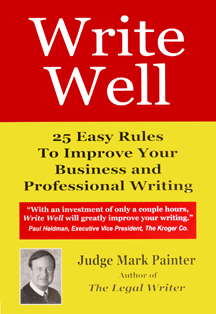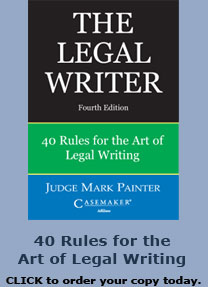The Legal Writer #24: It’s Not Only Lawyers and Judges
By Judge Mark P. Painter
Upon occasion, this column has highlighted some bad writing by lawyers and judges. There are always new examples. But we are not alone.
Each year, the journal Philosophy and Literature conducts a bad writing contest. It invites readers to send in examples of “the ugliest, most stylistically awful” sentences in academic writing. Here is one of two recent winners:
The move from a structuralist account in which capital is understood to structure social relations in relatively homologous ways to a view of hegemony in which power relations are subject to repetition, convergence, and rearticulation brought the question of temporality into the thinking of structure, and marked a shift from a form of Althusserian theory that takes structural totalities as theoretical objects to one in which the insights into the contingent possibility of structure inaugurate a renewed conception of hegemony as bound up with the contingent sites and strategies of the rearticulation of power.
The reading score of this 94-word gem is exactly 0 percent. As is this 55-word masterpiece of obfuscation:
If, for a while, the ruse of desire is calculable for the uses of discipline soon the repetition of guilt, justification, pseudo-scientific theories, superstition, spurious authorities, and classifications can be seen as the desperate effort to “normalize” formally the disturbance of a discourse of splitting that violates the rational, enlightened claims of its enunciatory modality.
The first excerpt is from someone who is a full professor at Stanford, while the second is by a full professor at the University of Chicago.
And lest you think these contest winners are isolated examples, I perused online some other “scholarly” writing. As with legal writing, bad examples are not hard to find.
This brings me back to the question of close reading, which I don’t see as a matter of fidelity to texts but rather as an attempt to surface the contradictions and struggles with which they are marked — in this case, again, the long and still ongoing struggle that today’s liberalistic discourses conduct against historical materialism and scientific socialism.
This example is a 55-word sentence, but it gets a readability score of 10 percent. Wow. Amazon.com tells us that the worthy author is an adjunct English instructor at Onondaga Community College in Syracuse, New York. But with the publication of this book of indecipherable writing, he will surely be promoted — perhaps to Stanford.
Another random example, and we are back to 0 percent readability:
In its reference to the historical images that circulate as floating signifiers in the condition of postmodernity, this story suggests that we attend to the consumption of commodified culture and recognize the signifying politics that embrace mass-media forms — concerns that are central to any analysis of the cultural characteristics of postmodernism.
When compared to the academic sophists above, even this legalese mess doesn’t seem too bad: Based on the findings and conclusions set forth with respect to each of the four areas of primary concern discussed above, the facts disclosed through our preliminary investigation do not, in our judgment, warrant a further widespread investigation by independent counsel and auditors.
But it is — it is an unreadable 43 words and scores 11 percent readability. And remember what the Ohio legislature is capable of:
Notwithstanding any section of the Revised Code that authorizes the suspension of the imposition or execution of a sentence, the placement of an offender in any treatment program in lieu of imprisonment, or the use of a community control sanction for an offender convicted of a felony, no court shall suspend the ten, twenty, thirty, or sixty consecutive days of imprisonment required to be imposed on an offender by division (A)(2), (3), (6), or (7) of this section, no court shall place an offender who is sentenced pursuant to division (A)(2), (3), (4), (6), (7), or (8) of this section in any treatment program in lieu of imprisonment until after the offender has served the ten, twenty, thirty, or sixty consecutive days of imprisonment or the mandatory term of local incarceration or mandatory prison term of sixty or one hundred twenty consecutive days required to be imposed pursuant to division (A)(2), (3), (4), (6), (7), or (8) of this section, no court that sentences an offender under division (A)(4) or (8) of this section shall impose any sanction other than a mandatory term of local incarceration or mandatory prison term to apply to the offender until after the offender has served the mandatory term of local incarceration or mandatory prison term of sixty or one hundred twenty consecutive days required to be imposed pursuant to division (A)(4) or (8) of this section, and no court that imposes a sentence of imprisonment and a period of electronically monitored house arrest upon an offender under division (A)(2), (3), (6), or (7) of this section shall suspend any portion of the sentence or place the offender in any treatment program in lieu of imprisonment or electronically monitored house arrest.
A 292-word sentence and we’re back to 0 percent. Remember, sentences of more than 35 words are not readable (exception — lists). Keep your sentences to an average of 18 words. Of course, even that wouldn’t save the readability of the academic writing examples. They are not written to be read — they are written to glorify the writer. And they are willfully obscure. At least when we are obscure, it’s not usually willful.
Readability
In each column, I list the two major readability statistics — remember, you can program Word to tell you these and more. Statistics for this column — my text only: 12 words per sentence, 9 percent passive voice. (Remember the 1818 Rule — no more than an average of 18 words per sentence and 18 percent passive voice sentences.) The readability score is 49 percent. That’s a bit low, but caused by the statistics — the same reason our readability goes way down when we put jumbles of letters and numbers (citations) in our text.
If we check the quotes, the word-per-sentence count goes to 99! The passive sentence count is 50 percent. And those quotes rate a reading-ease score of 0 percent. Last column, we saw an example (code) that was 4.6 percent, the lowest I had seen up to then. Now we know it actually goes to 0 percent. But only for academicians and legislatures.
____________________________________
Mark Painter is a judge on the Ohio First District Court of Appeals and an Adjunct Professor at the University of Cincinnati College of Law. He is the author of five books, including The Legal Writer 2nd ed.: 40 Rules for the Art of Legal Writing. The book is available at Joseph-Beth Booksellers in Cincinnati and Cleveland, The Book Loft in Columbus, the Ohio Book Store in Cincinnati, Barnes & Noble in Cincinnati (Kenwood), and from Ohio Lawyers Weekly Books at http://books.lawyersweekly.com. Judge Painter has given dozens of seminars on legal writing. Contact him at jugpainter@aol.com, or through his website at www.judgepainter.org.








